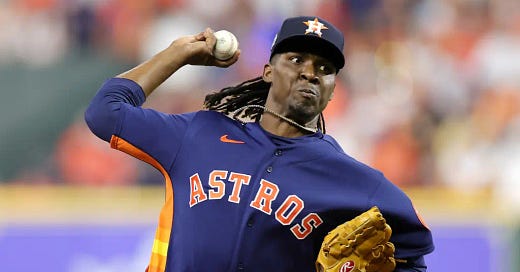Before the Trade: A Look Back at Rafael Montero’s World Series Masterclass
He just got dealt as a salary dump, but in 2022, Montero was the guy who held the Astros World Series title run together, one high leverage inning at a time
There’s something about timing in baseball. About when your best stretch shows up and what it means in the context of a season. Rafael Montero’s peak came and went fast, but it hit at the exact right time. October 2022. In the middle of one of the most dominant bullpens the postseason has seen, Montero was the guy who got outs when the game started to lean the other way.
Ten games. Nine and a third innings. One earned run. His usage wasn’t glamorous, but it was essential. Ryan Pressly was the closer. Bryan Abreu was the fire. Hector Neris brought tempo and rhythm. But Montero was the guy Dusty Baker called when the heart of the order was coming up in the seventh or eighth, and the lead didn’t feel safe yet.
In the ALDS, he was steady. Three games, 2.1 scoreless innings. He held a one-run lead in Game 2 with runners on, finishing the inning with a groundout from Cal Raleigh. The Mariners were pressing. Montero didn’t blink.
In the ALCS, he took on the middle of the Yankees’ lineup and didn’t allow a run across three appearances. In Game 1, he faced Anthony Rizzo, who had already gone deep earlier. The tying run was in play. Montero spotted up and got weak contact. In Game 3, he entered with two runners on in the eighth and Josh Donaldson at the plate. Montero worked fast. Splitter for a swing. Fastball up. Splitter down. Ground ball. Inning over. He wasn’t overpowering, but the sequencing was clinical.
By the World Series, the usage said everything. He was in four of the six games. The only run he gave up came in Game 1. After that, he locked in. In Game 4, he pitched the eighth inning of a combined no hitter. Cristian Javier started it. Abreu mowed down the seventh. Montero took the eighth and got through Alec Bohm, Bryson Stott, and Jean Segura on just twelve pitches. Ten were strikes. No walks. No stress. He threw three splitters that inning. two taken, one swung through. Everything else set up off the fastball.
Then came Game 5. Leadoff single. Walk. The go-ahead run came to the plate. For a second, it looked like he might unravel. But he didn’t. He got Kyle Schwarber to fly out on the first pitch and minimized the inning to one run. He gave the Astros enough. That’s what he did all postseason.
The pitch that made it work was the splitter. It sat 87 to 89 but didn’t need to dance. It just needed to fade late, which it did. It mirrored the four-seam fastball, which was 95 to 96 and carried well at the top of the zone. Montero tunneled both pitches out of the same slot. Lefties couldn’t square it up. Righties couldn’t sit dead red. It wasn’t flashy, but it disrupted timing. That’s all it had to do.
What came after doesn’t change what he was. The contract turned into an easy target, hree years, 34.5 million, and a fast decline. The results never came back. The command wavered. The fastball lost life. But it shouldn’t erase the version of Montero that showed up in October.
For one month, he was part of a bullpen that posted a 0.83 ERA across 54 postseason innings. Every arm knew its role, and Montero’s was to hold the game still before the final outs came. He didn’t dominate. He didn’t chase punchouts. He just made sure the Astros didn’t give anything back.
That’s what wins in October.
Montero didn’t pitch for attention. He pitched to get off the mound. And that might be the best thing you can say about a reliever in the postseason.
The Astros don’t throw a no hitter without him. They don’t hold those leads. They don’t win the World Series at all.
And if you watched closely, you remember.




